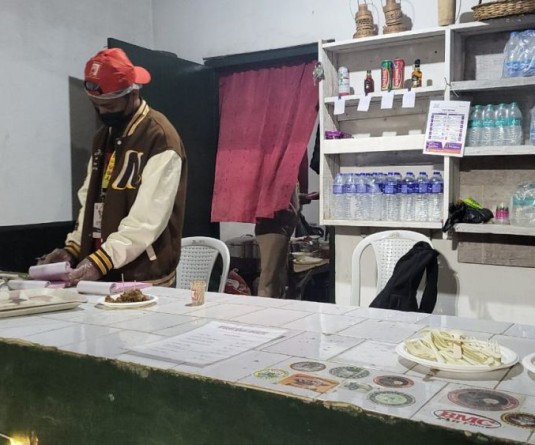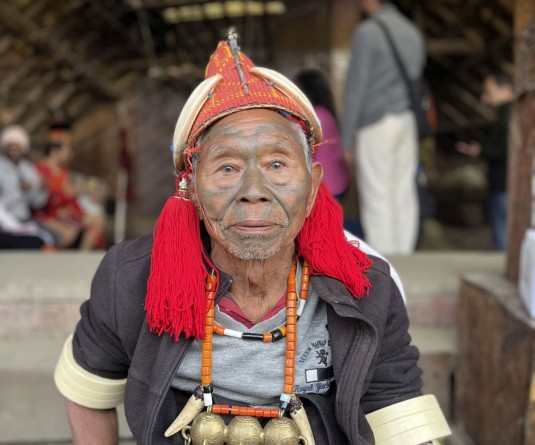Naga author Ovung Jungio.

Meribeni T Kikon
Wokha | June 7
‘A Kite of Farewells’ the second book by Wokha-born author Ovung Jungio is a collection of subtly striking tales gaining recognition far beyond the Northeast. The title alone, ‘A Kite of Farewells,’ evokes a poetic resonance, weaving together themes of memory, departure and the lingering presence of the past in the lives we leave behind.
Ovung, a professional with the Government of Nagaland’s Department of Art & Culture, is no stranger to artistic expression. His debut work, Kalopsia, was a collection of poetry. With ‘A Kite of Farewells’, he delves into larger emotional reservoir, starting with a terrifying nightmare that refuses to leave him alone.
For Ovung Jungio, the spark that lit the road to his latest book came in the unlikeliest of ways, a haunting nightmare in 2018 that left him shaken. “It was so vivid that I had to write it down as soon as I woke up,” he recalls. What began as a standalone story titled Scared Crow eventually became the emotional cornerstone of a deeply personal anthology that explores departures, memories, and the objects that quietly carry them.

The book’s title wasn’t always as poetic. “The original title was The Newspaper Kite,” Jungio confides. “But it didn’t carry the depth these stories needed. I don’t quite remember how A Kite of Farewells came to me, but it was the right choice.” The kite, now a recurring symbol, drifts through each tale, lifting moments of goodbye into the sky.
While the stories may read like fiction, Jungio’s writing is rooted in real emotion and lived experiences. “It’s not entirely imagined, nor purely autobiographical,” he says. “A nightmare, a conversation overheard in a café, a memory from a bus ride, these fragments grow into narratives.”
The book’s preface sets the tone for what follows: “Each story is tethered to an object that bears silent witness to the lives that once brushed against its form.” From clocks that resume ticking when grief lifts to chairs echoing with loneliness, Jungio’s stories exist at the intersection of the tangible and the intangible. They don’t just tell tales; they quietly observe the cracks in human experience where emotion seeps through.
Unlike his first book, which was completed in just four months, A Kite of Farewells was a slow-burning project. “Balancing competitive exams and work delayed the process, but I don’t fault myself for it,” he says. His writing rhythm varies wildly, sometimes in bursts of inspiration, and other times with more deleted words than written ones.
Interestingly, while he prefers to have a rough idea of where a story ends, Jungio leaves enough space for the unexpected. “I direct the flow, but I’m not someone who lets the story completely take the wheel. Still, endings often surprise me in the best ways.”
Some stories didn’t make it to the final manuscript. One titled Typewriter had to be cut. “Writers often talk about ‘killing your darlings.’ It hurt, but it was necessary to maintain the book’s emotional thread.”
Among the more challenging pieces, Code Blue stands out as emotionally taxing. “It’s a vicarious ‘what if’ about a lost friend from school,” he shares. On the creative end, Scared Crow demanded numerous rewrites and even received a new ending at the final hour.
The stories in the book are unified by a central theme, farewells. “Goodbyes are always difficult. But within those moments of parting, there is beauty, memory, and resilience,” he explains. “The kite symbolizes not just memory, but the act of release, the way we let go, or sometimes, try to.”
Writing the book was cathartic for Jungio, who used what he calls “method writing”immersing himself fully in his characters’ emotions. “It’s intense. It heals, but I also try not to bleed myself dry searching for pain in dark corners.”
There are layers waiting to be discovered in the book. In Eyes of the Tiger, a looming doom dissolves into the absurd, while Fire twists an ordinary moment into the macabre. Jungio clearly enjoys toying with tone and expectation.
Despite being more of a reader than a writer in his early years, storytelling was a constant presence in his childhood. “My mother told absurd bedtime stories, my father sang of his youth, and my brothers and I would trade tales by the fire.” This love of story eventually found a home on the page.
Among his literary influences, he names Robinson Crusoe for its imaginative grip, Julian Barnes’ The Sense of an Ending for its introspective brilliance, and Easterine Kire’s Bitter Wormwood as a key voice that showed him stories from Nagaland could belong on bookshelves everywhere. He also holds deep admiration for Avinuo Kire, who wrote the blurb for his book and whose fearless writing style he aspires to emulate.
Jungio hopes that A Kite of Farewells shows new readers the kind of writer he is—one who uses everyday objects and moments to reflect the depth of human emotion. “I want readers to find a voice that is both poignant and deeply human.”
The book has only been out for a short while, but it has already begun to find its readers. “One message on Instagram from a reader who found comfort in one of the stories meant the world to me. It reminded me why I write.”
He hopes that readers walk away from the book with empathy. “Especially for those who suffer quietly, who are discriminated against or feel invisible. Stories connect us in our shared experiences—joy, grief, hope.”
A review from New Asian Writing helped him view his own work in a new light. “They described the stories as psychological portraits cloaked in object-driven tales. That really struck a chord.”
Looking ahead, Jungio hints at a return to childhood roots with a potential horror anthology in the making. “Nothing’s set in stone, but I’ve always had a soft spot for the eerie and the unexplained.”
One phrase has become a guiding principle for him: Great things take time. It was advice given to him during a frustrating design project, but it resonated deeply while writing this book. “There were moments I wanted to quit, but that simple truth helped me hold on.”






